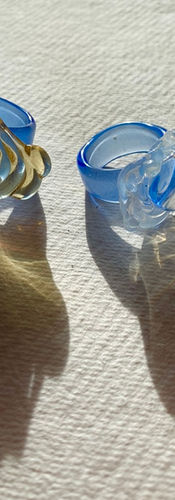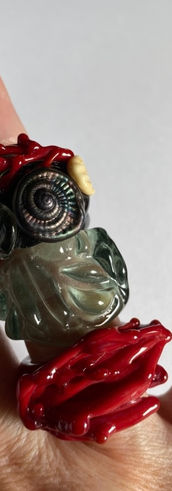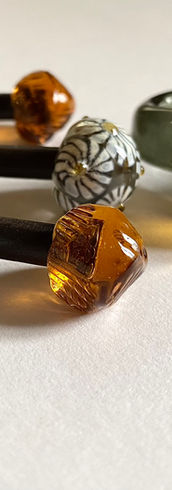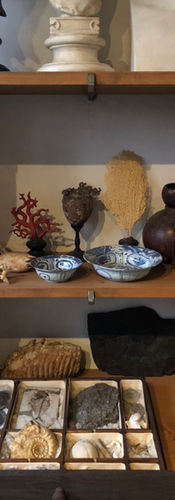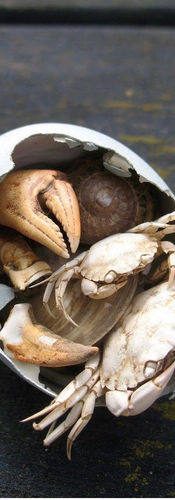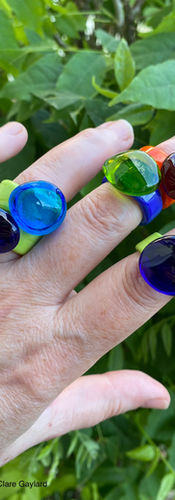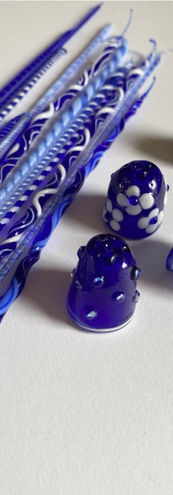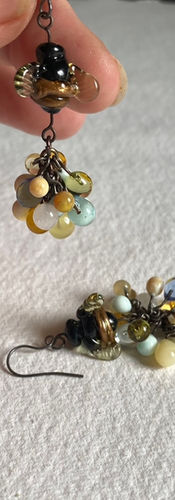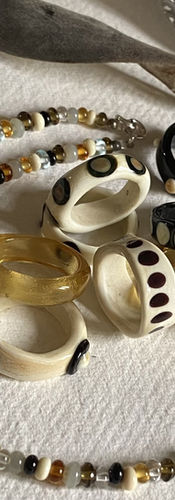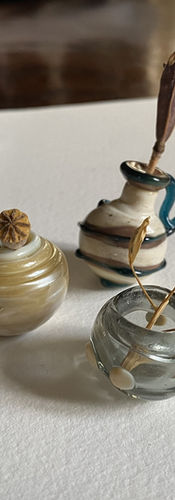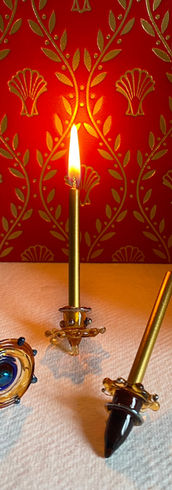Clare Gaylard Glass
Sometimes the abstract, textural or sculptural qualities of the molten glass informs my making. At others I'm caught up in a narrative, motif or colourway, frequently exploring a small object from nature or history, or a story as a microcosm or a talisman. I create contemporary jewellery using glass as my principal material and flame-work techniques to produce one-of-a-kind pieces. As a storyteller, I explore the role that jewellery plays as a wearable archive of experience, and the emotional resonance of adornment. My practice operates at the intersection between adornment and sculpture. My work interrogates the duality of glass as both a fragile and enduring medium, using it to evoke processes of memory, touch, and transformation. Find a selection of past and current work below.
Contemporary Heirlooms
Observing Italianate, architecture alongside the structures and cycles of plant forms. A National Trust collaboration with the Suffolk Craft Society. Inspired by Ickworth House, grounds and garden. Looking at the interior chandeliers prompted me to remove colour and opacity in favour of shifting light and form. The resulting 'ghost' effect being expressive of the continuing movement of seasons, generations and eras: 'Time present and time past Are both perhaps present in time future, And time future contained in time past.' Burnt Norton T S Eliot
Coast
Look, stranger, at this island now The leaping light for your delight discovers, Stand stable here And silent be, That through the channels of the ear May wander like a river The swaying sound of the sea. Here at the small field’s ending pause Where the chalk wall falls to the foam, and its tall ledges Oppose the pluck And knock of the tide, And the shingle scrambles after the sucking surf, and the gull lodges A moment on its sheer side. Far off like floating seeds the ships Diverge on urgent voluntary errands; And the full view Indeed may enter And move in memory as now these clouds do, That pass the harbour mirror And all the summer through the water saunter. 'Seascape' written for Benjamin Britten's music by W H Auden. Suffolk Coastal, where I live, was Britten's home, and the seaside town of Aldeburgh became the setting for his opera, 'Peter Grimes', as well as the M R James' ghost story 'A Warning to the Curious'.
On the World Stage
Exploring the effects of The Grand Tour on art, architecture and culture. A Suffolk Craft Society collaboration with The National Trust. Taking inspiration from a recent visit to Rome and The Pompeian Room at Ickworth House. The Fragmentary nature of discovered and collected elements of glass, plaster, coral, metal and stone. Gathering, holding, recording, collecting, preserving, conserving, creating, repairing, treasuring and maintaining.
Moth and Caddisfly
'Waif of the Summer night, A myth in velvet dust, So bent on idle quest! Frail devotee of light' Irony by Emily Dickinson
A Thousand Flowers
Millefiori (Italian: [ˌmilleˈfjoːri]) is a glasswork technique which produces distinctive decorative patterns on glassware. The term millefiori is a combination of the Italian words "mille" (thousand) and "fiori" (flowers).[1] Apsley Pellatt in his book Curiosities of Glass Making was the first to use the term "millefiori", which appeared in the Oxford English Dictionary in 1849; prior to that, the beads were called mosaic beads. While the use of this technique long precedes the term "millefiori", it is now most frequently associated with Venetian glassware. Wikipedia
Wunderkammer
'Cabinets of curiosities (German: Kunstkammer and Kunstkabinett), also known as wonder-rooms (German: Wunderkammer), were encyclopedic collections of objects whose categorical boundaries were, in Renaissance Europe, yet to be defined. Although more rudimentary collections had preceded them, the classic cabinets of curiosities emerged in the sixteenth century. The term cabinet originally described a room rather than a piece of furniture. Modern terminology would categorize the objects included as belonging to natural history (sometimes faked), geology, ethnography, archaeology, religious or historical relics, works of art (including cabinet paintings), and antiquities. In addition to the most famous and best documented cabinets of rulers and aristocrats, members of the merchant class and early practitioners of science in Europe formed collections that were precursors to museums.' From Wikipedia, the free encyclopedia. Theme for my 2024 solo show at The Quay Gallery.
Carnival and Colour Play
Allowing colours to speak to each other, permitting pattern and abstraction to take over. A day spent twisting colours into cane and making murrini is a reliable way to deal with a creative block.
Blue & White
A decade living in Kenya, Thailand and Singapore led to my fascination with the cooling vibrancy of this colour combination. I've an ecclectic and diminishing (increasingly cracked) collection of blue and white china, much of it hunted out as 'seconds' and oddments in the thrilling chaos of Chatuchak Market in Bangkok. Turkish tiles, Moravian wall motifs, Russian Gzhel, all of it!
Goddess & Garden
Fertility, flowers, fruit and the female form - recurring interests!
Pearl Hens and Seedpods
A studio visitor (who knows my work) brought me a collection of seed-pods, guineafowl feathers and a perfectly intact (deceased) beetle. These became the starting point for this monchromatic collection of glass.
Travelling Shrine/Illuminated Manuscript/Marginalia
A meeting of three themes. The essence of a cathedral, basilica, or temple as a talisman that can be worn or carried in your hands or pocket. A roadside shrine, a spirit house, a travelling shrine. My great-uncle, a parish priest had a workworn, silver, locket-like box to carry the Sacred host to the sick or dying. About the size of a pocket watch, and it opened to reveal a glowing gold interior. I’m fascinated by wearable and portable symbols of faith, talismans, relics and memento mori. My parents had a cloth-bound, boxed copy of the Très Riches Heures du Duc de Berry and the exotic imagery, glowing gold and intense colours fascinated me as a child. I managed to track down a rather battered copy for myself (no box) and became caught up in the character and chaos in the margins.
Harvest
Gathering beauty, seasonal changes. The forms reflecting the forms and growing habits of plants, berries and seedpods.














































